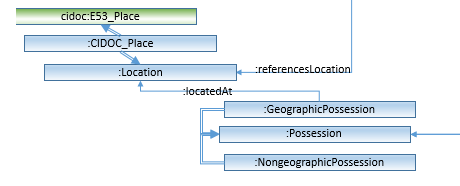FPO Locations & Possessions
For many of CCH/DDH’s factoid prosopographies property played a prominent role, and for this reason geographic location was also important, and was the reason why thinking about Locations and Possession together was a sensible thing to do. The following relationship properties are defined in FPO for possessions and geographic locations. All CCH/DDH projects expanded their structure beyond what is shown here. Some, for instance, included data to provide a geographic co-ordinate for locations.
The reader will have noted that we propose here a connection to CIDOC-CRM through its E53 Place class. No CCH/DDH project actually explored such a connection, so we propose it here as an idea worthy of consideration by other projects, particularly those who include materials which fit well under CIDOC-CRM’s domain.

Classes
- :Location: This is the class for geographic locations – presumably those connected to factoids. Because locations can also be possessions, some of them are quite specific places such as a particular church or other building. Several CCH/DDH projects organised this locations hierarachically, reflecting the hierarchical nature of much geographic administrative systems. Most CCH/DDH projects did not attempt to produce a historical reading of a location, but presented the places in modern terms.
- :CIDOC_Place: is a subclass of :Location and provides a mechanism within OWL/RDFS to make a connection between an FPO Location and the corresponding Place entity in CIDOC-CRM. We suggest here that the best connection is to CIDOC’s E53 Place class. Note that the formal connection is shown here by making CIDOC_Place not only a subclass of FPO’s :Location class, but of CIDOC’s E53 Place class as well.
- :Possession: This is the class for objects possessed by individuals or groups, and referenced in the factoids. Several CCH/DDH projects developed an elaborate classification system for possessions which goes beyond the two subclasses mentioned here, although all projects did make a distinction between land or place as possession and possessions which were not land.
- :GeographicPossession: is a subclass for possessions that are pieces of land or other kinds of specific geographic places such as buildings.
- :NongeographicPossession: is a subclass for possessions that are not geographic in nature. A common subclass here in CCH/DDH projects were for people as possessions. For them a further subclass could be added to FPO, and this subclass would be provided with a property that could link an instance of that class to the person or persons represented in :Person. This approach was done by one of the CCH/DDH projects: Charlemagne.
Properties
Although :Possession and :Location are, to some extent, peripheral to the central aim of FPO, they were thought of as important in several CCH/DDH prosopographies: possessions particularly for the charter-based projects (where, since most possessions in charters were properties, they were also linked to locations). Thus, several CCH/DDH projects add addition properties to Possession and Location structures to reflect other kinds of interests they have in this material. However, FPO defines itself only a couple of properties:
- : hasLocationName for :Location: provides a text string where the project’s standardised name for location is given. Note that this is conceptually different from the name as it appears in the source for a location. This name can be different from one reference to another, and is connected to the :LocationReference through its property :hasnameInSourceAs.
- :hasPossessionName for :Possession: provides a text string to contain the project’s standardisted name for a possession.
Relationships
The following relationship properties are defined in FPO for the possession and location set of classes:
- :referencesLocation (from :LocationReference to :Location): :referencesLocation is the mechanism used to link, through a :Reference, a factoid to a geographic location with which it is associated. Any number of :referencesLocation statements (and therefore factoids) can be linked to a particular :Location, but CCH/DDH practice had each :LocationReference link to only one :Location.
- :locatedAt (from :GeographicPossession to :Location): specifies the location associated with a Geographic Possession – a possession that has a geographic place associated with it such as a property.
- :involvesPossession (from :Transaction to :Possession): asserts that a particular possession (for CCH/DDH projects usually a piece of land) was involved in a :Transaction. Data models for CCH/DDH projects often allowed more than one possession to be associated with a transaction.
- :assertsPossessionOf (from :PossessionFactoid to :Possession): asserts that the :PossessionFactoid is referring to a particular :Possession object. Data models for CCH/DDH allowed for only one possession to be associated with a :PossessionFactoid.